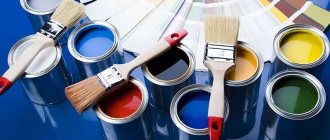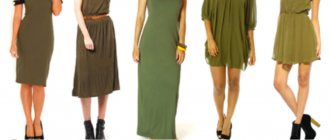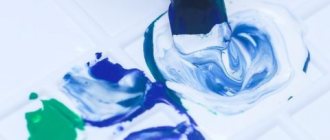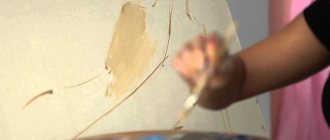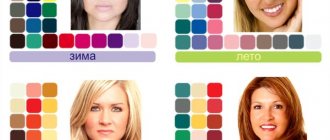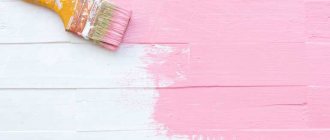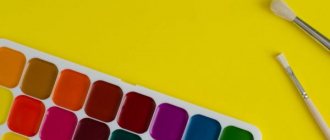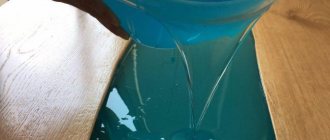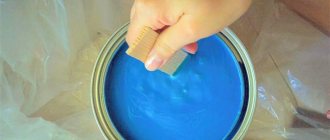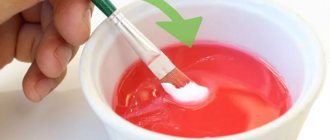Every person who has ever held a brush and paint in his hand knows that you can get a lot of shades from two or three colors. The rules for mixing and matching colors are determined by the science of coloristics. Its basis is the color wheel known to many. There are only three primary colors: red, blue and yellow. Other shades are obtained by mixing and are called secondary shades.
What colors of paint should be mixed to get brown?
Brown is considered complex; when creating it, you can use all the primary colors. There are several ways to get brown:
- Classic: green + red in proportions 50:50.
- The main trio: blue + yellow + red in equal quantities.
- Mixing: blue + orange or gray + orange. You can vary the intensity of the hue by adding less or more gray.
- Optional: green + purple + orange. This shade has a pleasant red or red tint. You can also mix yellow + purple - the color will have a yellowish tint.
| Combination | Proportions | Resulting shade |
| Green + red | 1:1 | Brown |
| Blue + orange Gray + orange | 1:1 | Tan |
| Yellow + purple | 0,8:1 | Tan |
| Red + yellow + blue | 2:2:0,5 | Red-brown |
| Light brown + indigo (black) | 1:1 | Chocolate |
| Green + purple + orange | 1:0,8:1 | Red-brown |
Calendar ritual songs
is a type of oral ritual folklore that is associated with traditional rites and customs.
In traditional society, folklore was an integral part of folk life. It accompanied the first plowing and harvesting of the last sheaf in the field, youth celebrations and Christmas or Trinity rites, christenings and weddings. Ritual songs were considered the same obligatory component of the ritual as the main ritual actions. It was even believed that if all ritual actions were not performed and the songs accompanying them were not performed, then the desired result would not be achieved.
Calendar-ritual songs belong to the oldest type of folk art and got their name due to their connection with the folk agricultural calendar - the schedule of work according to the seasons
.
In their form, these songs are short poems that in one stroke, two or three lines, indicate a mood, a lyrical situation.
For a long time after the adoption of Christianity, pagan holidays associated with the agricultural calendar continued to exist among the people, and their celebration was accompanied by corresponding ritual actions, games and songs. In one of the Russian chronicles of the 13th century, mention is made of a holiday in honor of the “demon of Kupala”, which “even to this day, in some areas, madmen commemorate.” On the night of June 23-24, when this celebration took place, “common people of both sexes gather and weave themselves wreaths of edible herbs and roots and, girded with greenery, make a fire, arrange green branches and, holding hands, walk around the fire singing songs, remembering Kupala; then they jump over the fire, making a sacrifice to this demon.” The Ukrainian chronicle, known as the Gustyn Chronicle, describes the ritual of caroling performed on Christmas Eve: “And they sing certain songs, in which they also remember the Nativity of Christ, and call the demon a great carol.” Adherence to these pagan rituals is also condemned in numerous church teachings.
As the Christian religion penetrated into the broad masses of the people, paganism as an integral system of beliefs began to disintegrate, and its individual elements were preserved only as a relic. A peculiar mixture of two religious systems took place, which the ancient Russian scribe calls “dual faith.” The people, as it were, adapted the dogmas of the Christian doctrine they had learned to their customs and ideas. Academician D.S. Likhachev drew attention to the fact that in church denunciations from the 12th century until the 17th century, “it is not belief in pagan gods that is condemned, but the performance of pagan rituals.” “And this is far from accidental,” adds the researcher. “The pagan rite not only in the 12th century, but also much later, continues to live independently of paganism itself.”
Freed from its practical life purpose and losing the meaning of direct magical influence on the forces of nature, the ritual increasingly became an element of the game, switching from the religious-magical to the aesthetic plane. D.S. Likhachev wrote:
This “switching” of pagan ritual could not take place at the end of the 10th–11th centuries, when the connection between pagan ritual and pagan religion was still too strongly felt. It became a real fact only from the period of feudal fragmentation, when the Christianization of the population made great strides
But if the system of beliefs and ideas about the world with which pagan ritual was associated was gradually forgotten and died out, then the external forms of the ritual turned out to be much more persistent and tenacious. They have not undergone significant changes since the time of Ancient Rus', as can be seen by comparing, for example, the chronicle description of the “commemoration of the demon Kupala” with how this joyful summer holiday dedicated to the day of John the Baptist was recently celebrated in the villages. The performance of ritual songs where they are still widely practiced is still subject to strict regulation, although its real meaning can hardly be explained by the performers. This applies primarily to calendar timing.
Songs of the calendar-ritual cycle (as opposed to lyrical and a number of others) are sung only at certain times of the year, and it was difficult to force a village singer to perform them at any other time.
The special manner in which they were usually sung is also characteristic. Here, for example, is how K.V. describes Kvitka boys and girls performing a carol that he recorded in 1898 in one of the Ukrainian villages:
The boys behaved very seriously and strictly during caroling, the girls - at ease, but modestly. The faces of the boys expressed awareness of the importance of the action being performed and concentration. <...> On the faces of the girls I did not notice any traces of any uplift, festive mood, artistic experiences... In their manner of deportment and in their facial expressions, the main thing was decency...
In another work by K.V. Kvitka writes:
I personally in Podolia above the Dniester observed only the restrained, solemn behavior of the girls, in one village even a gloomy expression on their faces when performing spring game songs.
In this peculiar manner of performing ritual songs one can see a relic of the time when the ritual was not yet a game, but a matter of great vital importance.
The ritual song was an integral part of the complex synthetic whole that was the pagan rite, and could not be conceived outside of this synthesis.
As noted by a number of researchers and collectors of folk art, it is never sung simply “for oneself”, alone during leisure hours. This is a song of collective action, always sung in chorus and, as a rule, accompanied by appropriate movements (round dance, dance, procession).
The stability and constancy of the forms of folk ritual gives reason to assume that the melodies of ritual songs have retained the features of the distant past in their melodic-rhythmic and modal structure. The ritual element present in the performance of many songs contributes to a careful attitude towards tradition and forces it to be strictly and carefully protected from individual arbitrariness and the penetration of alien elements. A particularly important role in the preservation of tunes is played by the functionality of folklore in general and in particular - the connection of songs with ritual, collective singing and the deep attachment of older generation peasants to traditions, which can be called “the unwritten laws of the village.”
Therefore, traditional peasant songs have become carriers of such specific information that the genre of a song can be determined by the tune alone.” The melodies of traditional peasant songs, and primarily those that belong to ritual or labor songs and are performed collectively, provide reliable material for studying the distant past of the musical culture of mankind.
Russian folk ritual poetry is closely connected with the old traditional way of life and at the same time conceals an amazing wealth of poetry that has stood the test of time for centuries.
Sources and additional information:
- prosv.ru - ritual folklore. Calendar-ritual songs (methodological advice on Russian literature for 6th grade);
- 1kessay.ru - calendar and ritual songs;
- veromed.in4post.ru — Keldysh Yu.V. History of Russian music. T. 1 (about calendar-ritual songs).
Additionally on Genon.ru:
- What is folklore?
- What is ritual folklore?
What colors of paint need to be mixed to get purple?
The easiest way to get purple is to mix equal proportions of red and blue. True, the shade will turn out a bit dirty, and it will need to be adjusted.
To make the tone cooler, take 2 parts blue and 1 part red and vice versa.
To achieve lavender and lilac, the resulting dirty purple needs to be diluted with white. The more white, the lighter and softer the shade.
Dark purple can be obtained by gradually adding black or green to the original color.
| Combination | Proportions | Resulting shade |
| Red + blue | 1:1 | Basic purple |
| Basic purple + white | 1:1 | Lilac, lavender |
| Basic purple + black | 1:0,5 | Dark purple |
| Red + yellow + blue | 1:0,5:1 | Purple |
| Basic purple + red | 1:1 | Red-violet |
Process Basics
Manufacturers of paints and varnishes presented a fairly wide range on the market. But it’s not always possible to choose what suits the interior perfectly. Combining several shades will help save time and money.
In many specialized stores you can use the services of a specialist who will help you make the desired color. But if you know the basic rules of how to mix dyes, you can do it yourself at home.
When mixing, you need to remember one important rule: you cannot combine liquid products with a dry mixture. They have different indices, so the coloring composition may eventually curdle.
The most interesting part of the process is creating the desired shade. There are four primary colors:
- white;
- blue;
- red;
- green.
By mixing them you can get any others. Here are some illustrative examples:
- You get brown if you combine red and green. To make a lighter shade, you can add a little white.
- Orange is the result of mixing yellow and red.
- If you need green, you need to combine yellow and blue paints.
- To get purple, you need to mix blue and red.
- Red and white will result in pink.
This way you can mix endlessly.
What colors of paint need to be mixed to get red?
Red is considered a base color and is present in any artistic palette. However, you can get red by mixing violet (magenta) and yellow in a 1:1 ratio. You can also mix a carmine shade with yellow to create a more intense red. You can make it lighter by adding more yellow and vice versa. Shades of red can be obtained by adding orange, pink, yellow, and white to the base red.
| Combination | Proportions | Resulting shade |
| Magenta + yellow | 1:1 | Basic red |
| Magenta + yellow | 2:1 | Burgundy |
| Carmine + yellow | 1:1 | Rich red |
| Basic red + yellow | 2:1 | Scarlet |
| Basic red + pink (white) | 2:1 | Pink-red (adjust saturation with auxiliary color) |
Table for obtaining shades of pink when mixing colors
This table shows how other colors influence the development of pink shades and how their undertone changes. The center is the main tone, around it are the primary colors for mixing, then to the periphery are the products of mixing the main tone and the adjacent shade in a ratio of 100:50, and then the percentage decreases to 100:20. Next to the main mixing product, the shades are darkened by 20% black and lightened by 20% white.
How to get other colors and their shades: theory and practice. Click on the icon.
One comment on “How to get pink by mixing paints”
- Vlad
March 4, 2021, 1:17 am
Thanks a lot.
What colors of paint should be mixed to get beige?
Beige color is a neutral and independent color; it has many shades, which can be achieved by varying the amount of white and yellow shades added.
The easiest way to get beige is to mix brown and white.
To make the color more contrasting, you can add a little yellow.
Flesh beige can be obtained by mixing scarlet, blue, yellow and white. The ivory shade is created by mixing golden ocher and white paint.
| Combination | Proportions | Resulting shade |
| Brown + white | 1:3 | Beige |
| Scarlet + yellow + white + blue | 1:1:2:0,5 | Nude beige |
| Golden ocher + white | 1:2 | Ivory |
Computer help
You can correctly mix several colors using special computer programs. They help you see the final result and determine in percentage terms how much of a particular tone needs to be added. Such programs will help you figure out what shade you can get from the products that are available. They consist of several elements:
- A button that removes tones from the set.
- Color names.
- Lines of input or output to or from a calculation.
- Samples.
- A button that introduces colors into a set.
- Result windows.
- New selection window and list.
- Composition of the finished dye in percentage terms.
Mixing several different colors is a fairly common technique among designers. Unusual shades will help to decorate the interior favorably, make it original or even unique. You can even mix dyes at home. There are many recipes for creating one shade or another. For example, to get beige you need to combine white and brown, and to get pink you need to combine white and red.
It is recommended to always have a thinner on hand that will prevent the paint from drying out quickly. You should not mix products from different manufacturers, because the result will be a poor-quality coating. To find out the final result of mixing, you can use a special computer program.
When taking their first steps in working with decor, most artists are faced with the problem of the lack of many shades in standard paint sets. And in everyday life, the need to obtain different tones arises quite often: from choosing a color for painting the walls in the house to choosing the ideal eye shadow. However, do not be upset if your existing arsenal of paints does not contain the necessary element. Remember, with only three basic colors: yellow, blue and red, you can get any shade existing in nature. So, to get orange, you just need to mix two basic colors: red and yellow, and also become familiar with some of the nuances that artists use when mixing paints.
First, let's prepare everything you need. You need to bring:
- surface for mixing (for example, a palette);
- yellow and red paint;
- brushes;
- canvas or other work surface on which the resulting material is planned to be applied (watercolor paper, pastel paper, etc.).
The result of mixing yellow and red paint
To ensure that the final color is perfect, before starting work, make sure that the surface is free of foreign particles (lint, dust particles, brush hairs, etc.). You also need to immediately decide which method you plan to obtain the desired orange tone. If mixing is done on paper, the final shade is obtained by overlapping the tone after applying one layer of composition to another. If you mix colors on a palette or jars, the result is a separate new tone.
What colors of paint need to be mixed to get green?
Green color can be achieved by mixing yellow and blue in equal parts. The result will be a grassy green hue. If you add white color to it, the mixture will lighten. By mixing brown or black pigment, you can achieve emerald, marsh, olive, dark green shades.
| Combination | Proportions | Resulting shade |
| Blue + yellow | 1:1 | grassy green |
| Blue + yellow + white | 1:1:0,5 | Light green, salad |
| Blue + yellow + black | 1:1:0,5 | Swamp, dark green |
| Yellow + blue + brown | 1:2:0,5 | Gray-green |
Details
Shades of yellow
These include not just light yellow and dark yellow colors, but also golden, beige, wax, bronze, lemon, khaki, amber, apricot, ocher and others.
Shades:
- Golden - is the main one in icon painting for Orthodox believers, and is a brilliant yellow shade.
- Apricot is a yellow-straw shade.
- Bronze is a golden brown shade or dark yellow with a characteristic shine.
- Waxy is a light, even pale yellow.
- Khaki is greenish-yellow, with the first color predominant.
- Lemon is a bright yellow color that has a light green tint.
When buying paint at a hardware store, you can note that all manufacturers try to give their own names to the shades they produce. For example, it could be golden palm, golden harvest, Inca gold, narcissus and others. You can achieve a new shade by mixing certain colors in different proportions.
Methods for creating yellow
Although this color is considered the main color, it cannot be achieved by mixing other colors, and if you have watercolor paints, as well as landscape sheets, there is still a chance to get the desired effect. So how do you create yellow from paint materials? To do this, mix orange with green. But here you need to immediately take into account that as a result you will only get a color close to yellow, and the predominance of green will be noticeable.
For this reason, when painting with paints, it will be preferable to use exactly the tone that will make it possible to convey the desired effect. Experts who create televisions and other equipment that transmit color images to the screen know how to obtain yellow from the rest. In this case, red and green are mixed to obtain yellow.
Please note that when mixing oil or watercolor paints of red and green, it will not be possible to achieve a yellow tint.
And yet, by mixing certain shades, you can get a variety of shades of yellow. For example, painting wall surfaces with dark yellow paint can result in golden, lighter, or even lemon-colored variations.
Rules for mixing paints
Before you start mixing paints and getting a yellow color, you should experiment with a small amount of paint and make a sample. If done differently, the entire volume may be rendered unusable. So, to get yellow paint, you first need to prepare a small container with a volume of 0.2-0.3 liters and pour 0.1 liter of base paint into it. Next, add another color in an amount of 2 to 5 ml and mix the entire composition thoroughly. This way, you can add pigment paint to the base color until you get the desired result. It is worth calculating the amount of added pigment - this will make it possible in the future to maintain the exact ratio when diluting the paint and varnish composition in containers with a large volume.
- Dark yellow color
As mentioned above, to get yellow you will need to mix green and orange paint, and this combination will give you a dark version of yellow. If you want to get a pure dark yellow color, you need paint with a base color and brown. To obtain a tone, mix these paints in separate containers. The brown one will be added in portions to the yellow one, and after adding everything will be thoroughly mixed. This procedure should be repeated until the desired result is obtained. And to make dark yellow brighter and more saturated, you will need to add a little red along with the brown paint.
- Bright yellow color
To obtain a similar tone, the base paint should be diluted with white and also orange until you get the desired result. When adding white paint, you should wait so that the amount is not too much. Otherwise, together with a rich and bright yellow, you will get a dull and pale shade.
- Yellow with gold
To achieve a similar tone, add gold and a little red/brown paint to the original paint. It should be added to the main color in small portions, mixed thoroughly before adding new portions until you get the desired result.
- Juicy yellow
Even schoolchildren know how to mix orange from paints - this requires combining red and yellow. Please note that the amount of certain pigments will determine whether the orange shade will be bright or pale. The optimal proportions for obtaining orange color will be 1 to 1.
Please note that if the amount of orange is much less compared to yellow, the result will be a rich color.
Thus, to get a yellow color that is juicy, you will need to mix red and yellow.
What colors of paint need to be mixed to get gray?
The classic tandem for getting gray is black + white. The more white, the lighter the finished shade.
- You can also mix red, green and white. The color will have a slight yellow tint.
- A blue-gray shade can be created by mixing orange with blue and white.
- If you mix yellow with purple and white, you get a gray-beige shade.
| Combination | Proportions | Resulting shade |
| White + black | 2:1 | Light gray |
| Red + green + white | 1:1:2 | Gray-yellow |
| Orange + blue + white | 1:1:2 | Gray-blue |
| Yellow + purple + white | 1:0,5:2 | Gray beige |
Creating the most unusual shades
How to mix paints to produce a particular color
The formation of all possible shades of one color is a whole science. Sometimes, achieving an accurate result is not easy. By adding black, white or gray to the base pigment we can get different results. You can also vary the proportions of mixed colors.
This process often takes a long time if there is no appropriate preparation. It is especially difficult to work with selection for an already painted part. A colorist who does not have a prescription can independently obtain the appropriate shade. Light plays an important role in the room where work takes place. It is better to prepare the necessary conditions and access to natural light in advance. Any fluorescent lamp will distort the colorist’s work.
Brown
It is often used when painting canvases; it is obtained quite simply:
- Herbal + scarlet;
- Scarlet + blue + bright yellow;
- Scarlet + a drop of white + black + one drop of yellow.
- Mustard is easy to create by mixing yellow + red + green + black.
- Tobacco is scarlet, green, yellow, white.
- Bright brown in autumn - a combination of bright yellow, scarlet, green, white, blue.
Violet
An interesting purple can be obtained by mixing blue + red, or blue + pink.
Formation of many tones of violet: light violet can be quickly diluted with the existing dark color with white, carefully adding it one drop at a time.
For a crimson tint in purple, you need to include more drops of scarlet color.
Red
Juicy, fiery. It is difficult to imagine the modern world without it.
You won't be able to get real red. But with its help you can create many shades.
- Chestnut is red + black.
- Bright fiery orange color - red + a little yellow.
- Dye magenta – blue + yellow + red pigment.
- The color of ripe raspberries is red + white + brown + blue.
Beige
This delicate and laconic color scheme can play in many shades. You can often find beige in design, calm interiors and a colorist’s workshop.
Brown + white - we will create beige. And adding basic colors to it drop by drop - adjust from warm to cold colors.
Green
The most pleasing color to our eyes. They love to use it when creating interior plans, and when creating canvases it is simply necessary.
How to get green? The most logical thing is to add blue to yellow. If you add more bright blue, the color will be more saturated, and if you add white, it will be mint. The needles are the result of a mixture of bright grass, black and yellow.
Grey
Modern design is indispensable without gray. It is valuable because it goes with everything. And it’s impossible to count how many shades a colorist can create from this color.
You can get gray by adding white to black. You can also always add one of the colors of the rainbow for experimentation to give bright tints and change the tonality.
Black
The deepest, as well as the most necessary in the palette. With its help, the artist will quickly depict a shadow or adjust any color to the desired tone.
Deep black will be mixed from blue and dark coffee. Also combine blue, red, yellow in equal proportions. Exquisite varieties of black:
- asp (with a piece of gray color);
- anthracite (with a metallic sheen);
- bull's blood (beautiful tints of scarlet).
Blue
Often used by colorists. No artist can do without it when depicting the sky, lakes, ice and other common elements.
Beautiful blue, as the main one among many colors, cannot be formed by repeated mixing. Mix purple with soft blue - the paint will be too dark. You can lighten it by adding a few drops of light pigment.
Yellow
True yellow also cannot be obtained by mixing other available paints. By carefully adding light green to orange you can achieve only the same.
Pink
Bright snow-white paint is used as the basis for pink. Scarlet is added to it drop by drop. The more intense the shade needed, the more scarlet should be introduced, this is how the required tonality is controlled.
Orange
How to make orange? Let's combine rich yellow and scarlet paint in one ratio, then adjust:
- For light orange, take bright pink + yellow, and if necessary, you can also include a few drops of white;
- For coral, dirty colors are combined - orange, pink, white in a similar ratio;
- For a delicate peach you need orange, yellow, pink, perhaps a drop of white;
- For copper we use bright orange + a drop of coffee. You can add brightness to the color with white, gradually adding one drop at a time.
What colors are already in your palette? Which ones are you planning to mix for yourself?
There are no limits to a person’s imagination to try, experiment, and invent their own interesting colors. You can combine one with the other, creating something new.
If you find that a particular color is missing from your palette, you will no longer doubt it, but create it for yourself from what is at hand. The colorist already has all the necessary tools; you just need to know how to do it.
As a child, it is difficult to understand the process of mixing and obtaining new colors, but these tools will help your child quickly navigate and spend a long time engaged in his favorite drawing with interest.
What colors of paint need to be mixed to get black?
Black is a basic monochrome color. It can be obtained by mixing magenta with yellow and cyan. Also, artists often mix green and red, but the resulting shade will not be jet black. Rich black color is produced by a mixture of orange and blue and yellow and violet. To get the shade of the night sky, you can add a little blue to the finished color, and a drop of white to lighten it.
| Combination | Proportions | Resulting shade |
| Red + green | 1:1 | Dark brown, almost black |
| Magenta + yellow + cyan | 1:1:1 | Black |
| Blue + orange | 1,5:1 | Night sky |
| Orange + purple | 1:2 | Black |
Tips for creating a new color
When figuring out which paints to mix to get yellow, don’t forget about the mixing rules. Step by step it looks like this:
- The base is applied to the palette;
- A thin brush takes a few drops of additional material and applies it to the base;
- The base is thoroughly mixed until a homogeneous mass is obtained. If necessary, add more color to achieve the desired result.
The task of making yellow is quite simple. With the right proportions you will get the desired result. Usually, to create the required undertone, 50 ml of base and 2-3 ml of another color are required.
If there is too much additive and the tone turns out to be dark, you can correct the situation with the help of white. If you mix the base with white, you get an elegant color scheme with highlights.
Yellow paint, regardless of shades, always turns out juicy and cheerful. Therefore, designers like to use it when decorating the interior. The harmony of warm and cold always looks elegant. Golden color is often used by artists in icon painting.
What colors of paint need to be mixed to get blue?
Blue is the main color in the palette and it is quite difficult to obtain it by mixing. It is believed that it can be obtained by adding a little yellow to green, but in practice the result is more of a blue-green tint. You can mix purple with blue, the shade will be deep but dark. You can lighten it by adding a drop of white.
| Combination | Proportions | Resulting shade |
| Yellow + green | 0,5:1 | Blue-green |
| Purple + blue | 1:1 | Blue |
| Purple + light blue + white | 1:1:1 | Light blue |
| Basic blue+ black | 3:1 | Dark blue, blue-black if you add more black |
How to get gray: mix black and white
Gray color is obtained by mixing white and black, but this proportion cannot be one to one. To get a medium gray tone you need to take at least 5 parts white and 1 (one) black. In practice, it will look like this: squeeze a pea of white paint onto the palette and 3 times less black next to it, then carefully take it on the tip of the brush and dip it into white. By adding drops of dark color to white, you can adjust the degree of darkening of the gray color.
The colors obtained in this way will be “pure” and are the basis for further mixing to acquire any undertone.
What colors of paint need to be mixed to get yellow?
The basic yellow color cannot be achieved by mixing other shades. Something similar happens if you add green to orange. Variations of yellow are obtained by adding other tones to the basic one. For example, lemon is a mixture of yellow, green and white. Sunny yellow is a mixture of basic yellow, a drop of white and red.
| Combination | Proportions | Resulting shade |
| Orange + green | 1:1 | Dirty yellow |
| Basic yellow + green + white | 1:0,5:0,5 | Citric |
| Basic yellow + white + red | 4:1:1 | Sunny yellow |
How to mix achromatic colors
There is such a painting technique as grisaille. It involves creating a painting using gradations of exclusively achromatic colors. Sometimes brown or another shade is added. Below is a table of mixing colors for paints when working using this method.
Please note that when working with gouache, oil, or acrylic, a grayer shade is created by not only reducing the amount of black, but also adding white. In watercolors, professionals do not use this paint, but dilute it
What colors of paint need to be mixed to get pink?
The easiest option is to mix red and white. The more white, the lighter the shade. It is important to know that the tone depends on which red you choose:
- Scarlet + white will give a pure pink color.
- Brick red + white – peach pink.
- Blood red + violet give a fuchsia shade.
- Orange-pink can be obtained by adding yellow paint to scarlet and white.
| Combination | Proportions | Resulting shade |
| Scarlet + white | 1:2 | Pink |
| Brick red + white | 1:2 | Peach pink |
| Purple + blood red | 1:1 | Fuchsia |
| Scarlet + white + yellow | 1:2:1 | Orange pink |
Making pink from different dyes
Always remember the basics. Oil paints mix with oil paints, acrylic and watercolor paints mix with themselves and with each other. In the case of building materials, it is also necessary to look at the properties: paints for facade and interior work, thanks to a single base, mix well, but due to various additional components they have poor covering ability.
Shades of pink are widespread in painting
Pink when working with art paints
First you need to decide what type of paint you want to get pink from:
- Watercolor. To get pink from watercolor, you can use carmine or plain red. Add one of these colors to the palette, and then gradually dilute with water to the desired shade. Remember that watercolor will fade slightly as it dries.
- Gouache. Pink shades are obtained according to the principles proposed above. These paints dry quickly and lose their saturation after drying. In this regard, a layer-by-layer technique is suitable for these compositions.
- Acrylic. This type of paint is convenient in terms of adjusting brightness. Pink from acrylic paints is obtained by thorough mixing, since distribution of the pigment in a thick medium takes longer.
- Artistic oil. To obtain pink, add a large amount of zinc white to red carmine. The tone also depends on the thinner. Flaxseed oil is best, while kerosene or sunflower oil adds yellowness.
To change the saturation after drying, the watercolor can be covered with a second layer or washed with water. The acrylic and oil can be scraped off or the desired shade can be applied on top. Gouache can be adjusted with a second layer on top of the first after it has dried.
You can also learn in detail how to work with oil paints.
Pink from construction paints
In order to get pink, a construction color is used in a ratio of 2-3 teaspoons per 10 liters of water-soluble white paint or 20-25 liters of alkyd enamel. Kohler is a pigment extract that has a high coloring ability.
Tinting paint has many nuances, so you can achieve the desired color only experimentally, first taking a little and then gradually adding dye.
What colors of paint need to be mixed to get orange?
Orange color can be obtained by mixing red and yellow.
- A less saturated shade will be obtained if pink pigment is added to yellow paint.
- Terracotta orange is the result of mixing base orange with blue or purple.
- Dark shades are achieved by mixing red, yellow and black.
- If you add brown instead of black, you get red orange.
We vary the intensity of the tone by adding more white or black.
| Combination | Proportions | Resulting shade |
| Red + yellow | 1:1 | Orange |
| Pink + yellow | 1:1 | Light orange |
| Red + yellow + purple | 1:1:0,5 | Terracotta |
| Red + yellow + black | 1:1:0,5 | Dark orange |
| Red + yellow + brown1 | 1:1:1 | Ginger |
How to get olive drab color
If you need to paint a shadow cast by greenery on a sunny day, then an olive-gray shade would be ideal. This is a warm, neutral khaki, which is obtained by mixing an existing gray shade with a drop of yellow. Mixing it on the palette will look like this: in front of you is already mixed black and white paint, squeeze out a small amount of yellow paint nearby (about the same amount as black) and add it to the gray with a brush stroke. To create an undertone you need a minimal amount of paint. It is worth considering that yellow is a light paint, so if you have precisely selected the lightness of gray, the resulting shade will be a little lighter than planned.
